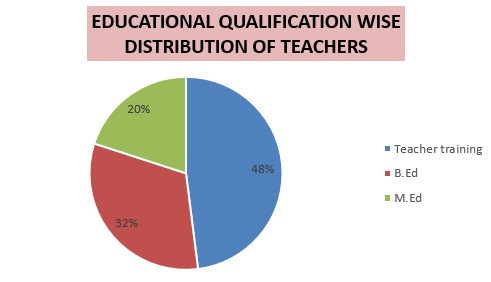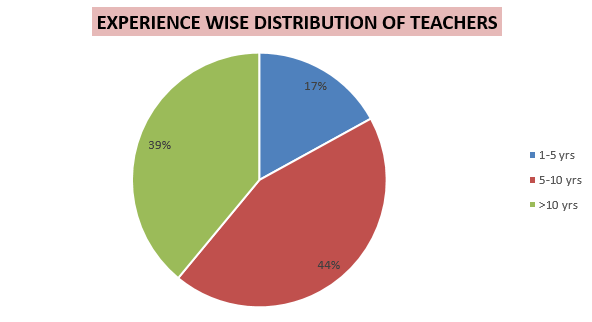Introduction
Apart from home, school is the single most important place in the life of most children. Their experience of school will play a vital part in their life and will determine their academic, social and, probably, their occupational future.1
Guru Brahma, Guru Vishnu, Guru Devo Maheswarah Guru Sakshath Para Brahma, Tasmai Sree Guruve Namaha
The Hindu philosophy places teacher on a pedestal – even above God and just after the parents. Children spend most part of their working hours in school with teachers who play an important role in molding their future. A teacher is responsible to integrate all round development of a child. Like a gardener, they provide all suitable conditions for student’s best growth.2
Families lay the foundations for a feeling of security. At its best, the family is the base from which the child learns to face and cope with the anxieties of life. Apart from home, school is the single most important place in the lives of most children. Their experience of school will play a vital part in their lives and will determine their academic, social and, probably, their occupational future.3
The growth in the number of children with disabilities exceeds the growth in both the resident population and the school enrollment. But, according to Prasad M, the Mental Health Services available to provide psychological care to emotionally disabled children in India is very meager. WHO insisted on the fact that, mental health program should utilize trained teaches to improve the psychosocial aspect of the school children. A mental Health input in the School Health Program is likely to play a major role in the amelioration of social, behavioral and learning problems in school children. Research studies supported the use of teacher ratings for initial screening and identification of students at high risk for social-behavioral problems.4, 5, 6 As a method of management teacher must assess their ability, interest, creativity and commitment to the specific field areas of the human endeavor. This process utilizes the teacher’s knowledge of the child through observations of student behaviors within the le1arning environment. While dealing with underachievers, this knowledge will help in differentiating children, who are lazy and will not do the work or teach disabled who cannot do the work.7
Lack of awareness among parents and school teachers continues to pose a significant issue. The children with learning disability have trouble with expressing their feelings, calming themselves down. These children are at risk of developing low self-esteem and also have very fewer friends and they are one and half times more likely to drop out of schools. So, they need to identified at the earlier stage and proper guidance and training should be provide to them. With large numbers of students identified with learning disabilities in schools across India, it is only appropriate to determine if teachers are adequately prepared to make learning and performance effective and efficient for this special population of students. Teachers need to have adequate knowledge of the cognitive, linguistic, neuropsychological, behavioral, and social characteristics associated with learning disabilities, so that they are able to design instructional models that work for these students. Knowledge of learning disorder among teachers is also needed for another reason, in order for professionals to avoid stereotypical descriptions of individuals with learning disorder, Because the success of inclusive classrooms is related to teachers’ knowledge of the unique needs of their students.5, 6, 7, 8
Investigator during school health programs noticed that all the students were forced to follow the same syllabus irrespective of their difference in the capacity to learn. Students who were weak in their scholastic behind their poor performance. Without knowing that poor performance can be a brain disorder, teachers were ill- treating them, which in turn further reduced their confidence. Similarly, no attempt was made to identify and faster their capabilities in other fields. Hence, researcher felt that it is important to understand the knowledge and attitude of teachers towards the child’s disabilities. Moreover, related studies were found to be very few in Indian setting. This observation inspired the researcher to conduct a study to assess the effectiveness of Self-Instructional Module [SIM] on knowledge regarding selected learning disabilities in primary school children among primary school teacher's in selected schools of Indore (M.P.).
Problem Statement
“A study to assess the effectiveness of Self-Instructional Module on knowledge regarding learning disabilities in children among primary school teachers in selected schools of Indore (M.P.).”
Objectives
Objectives of study
To assess the pretest knowledge regarding learning disabilities in children among primary school teachers.
To assess the posttest knowledge regarding learning disabilities in children among primary school teachers.
To assess the effectiveness of self-instructional module on knowledge regarding learning disabilities in children among primary school teachers.
To find an association between pre-test knowledge with selected socio-demographic variables.
Hypothesis
RH1 – There will be significant difference between pre-test and post-test knowledge score regarding learning disabilities in children among primary school teacher at the level of P≤0.05
RH2 – There will be a significant association of pre-test knowledge score with selected socio-demographical variables at the level of P≤0.05.
Sample and setting
In the present study the sample comprised of 100 primary school teachers of Kamala Nehru Higher Secondary School, Gurukul Higher Secondary School, Indore (M.P.).9, 10, 11, 12, 13, 14, 15, 16
Tool and data collection
Tool used in the study is structured knowledge questionnaire. It consisted of two parts:
Section (Socio- Demographic variable)- Demographic data consists of 8 items seeking information about age, gender, marital status, educational qualification, years of experience, child psychology in the curriculum, previous knowledge and experience in teaching children with learning disability.
Section (Structured Knowledge Questionnaire)- Consists of 40 questions related to meaning, incidences, causes clinical features, diagnosis and management of a child with learning disability. Each question has one correct answer that carries one mark and wrong answer carries 0 mark. The maximum total score of the knowledge questionnaire was.
Description of self-instructional module
Self-instructional module includes 7 chapters related to introduction, meaning, causes, diagnosis and management of various learning disorders. The learning disorders discussed in the self-instructional module are reading disorder, of written expression, mathematical disorders, autism and attention deficit hyper activity disorder.
Data collection procedure
The study was conducted at Kamala Nehru Higher Secondary School, Gurukul Higher Secondary School, Indore (M.P.). The investigator introduced himself to the subjects and explains the purpose of the study. Written consent from the subject was taken and they were made assured about the confidentiality of the results. Pre test knowledge was assessed using structured knowledge questionnaire to assess the existing knowledge of primary school teachers on the first day.On the same day self instructional module was distributed among the samples and instruction to use SIM was explained and the date for the post test was priorly informed to them. Post test assessment was done using the same questionnaire among the primary school teachers after 5 days. Duration of the data collection was 6 weeks. The investigator thanked and appreciated all participants for their co-operation.17, 18, 19, 20, 21, 9
Result and Interpretation
Table 1
Frequency and percentage distribution of primary school teachers according to their demographic variable N=100
The above table Table 5 Shows that the frequency and percentage distribution of parents according to their socio demographic variables.
In age of primary teachers 20% of samples are in the age group of 26-35 years and 45% in 31-35 years, 15% are in the age group of 21-25 years and 20% above 35 years,
In gender of teachers, 10 % was male teachers, 90% was the female teachers
In educational qualification of the primary school teachers, in 48 teachers had teachers training certificate, 32% of Teachers had B.Ed., 20 % had M.Ed.,
In experience of teachers, 17% of the teachers have 1-5 years, 44% of the teachers have 5-10 years of experience and 39% of the teachers have above 10 years of experience,
The above figure shows majority of school teachers are married 83 % & 17% are unmarried.
The above figures show child psychology in curriculum results that 51% had child psychology in curriculum and remaining 49% teachers not had child psychology in curriculum.
In attended in service education 22 % of teachers attended in service education and 78% of teachers not attended in service education.
The above figure shows experience in teaching children with learning disability is 56% had experience, 44% had no experience.
Figure 3
Pie diagram representing percentage distribution of child psychology in syllabus of teachers
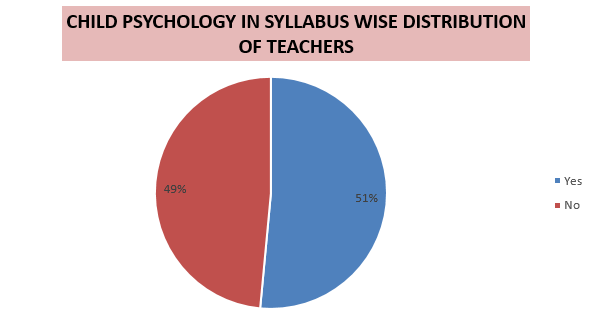
Figure 4
Pie diagram representing percentage distribution attended in-service education by teachers.
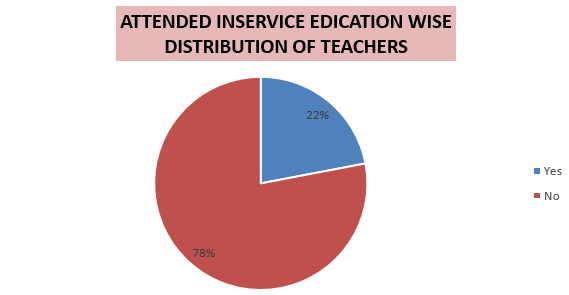
Section II: Comparison of pre test and post test level of knowledge of primary school teachers.
Table 2
Comparison of pre-test and post-test knowledge score N=100
Figure 5
Bar chart representing the comparison of pre test and post test knowledge score of teachers.
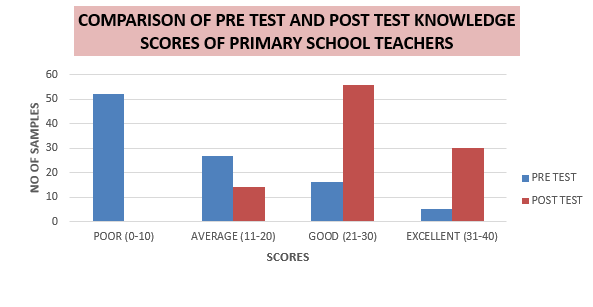
Table 3
Effectiveness of self Instructional module knowledge of primary school teachers regarding learning disabilities N=100
|
Test |
Mean |
Standard deviation |
“t” value |
|
Pre test |
12.4 |
9.4 |
“t” cal =18.67 df=99 |
|
Post test |
26.6 |
13.3 |
“t‟ tab=1.66 P=0.05 HS |
Figure 6
Bar chart representing the comparison of mean pre test and post test knowledge score of teachers.
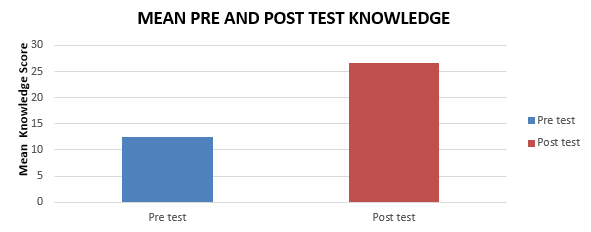
Table 4
Association between demographic variables andpre test level of knowledge (N=100)
It is observed in Table 3. that the majority of primary school teacher’s pre test knowledge scores were poor 52%, 27%were having Average, 16%were having Good and only 5% were having Excellent knowledge score. Whereas post-test knowledge score 56% were having good, 30% were having Excellent, 14% were having Average and none of the teachers had poor knowledge.
Section III: Effectiveness of the self-instructional module on knowledge of primary school teachers regarding learning disabilities.
Above data Table 3. depicted that the mean of post-test knowledge scores was 26.6, which is significantly higher than mean of pre-test knowledge scores of 12.4. Standard deviation of post-test score and pre-test score is 9.4 and 13.3 respectively. The computed paired “t” value (18.67,df=99 at the level of P= 0.05) is greater than table value (1.66) which represents significant gain in knowledge. Hence the hypothesis H1is is accepted.Section IV: Association between pre test knowledge scores with their selected socio-demographic variables.
Association between the pre test knowledge score with the selected demographic variables.2: There will be significant association between the pre test knowledge score and selected demographic variables at the level of P≤ 0.05. is accepted as there is significant association between pretest knowledge score and selected demographic variables like educational qualification, years of experience, child psychology in syllabus and attended in-service education.
Conclusion and Summary
The study revealed that the level of knowledge regarding learning disability was low among school teachers in pre test and there was significant gain in knowledge in post test. Thus the study results revealed that self-instructional module is an effective instructional method to improve the knowledge level of primary school teachers regarding learning disabilities.

